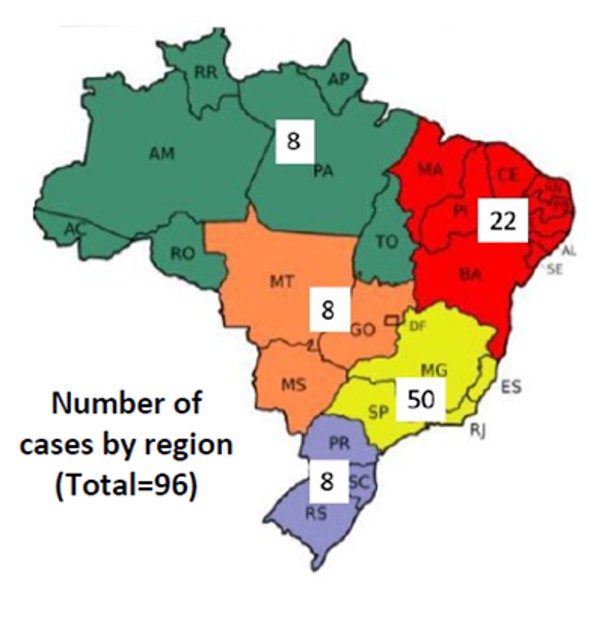Session Information
Session Type: Poster Session B
Session Time: 10:30AM-12:30PM
Background/Purpose: Ultraviolet (UV) waves are risk factors for juvenile dermatomyositis (JDM), when compared to other types of myositis without skin involvement. Patients with JDM have photosensitive lesions that can result in increased disease activity from varying sun exposure. Rider, L. et al. (2020) demonstrated the relationship between UV exposure and the risk of developing DM in adults, with individual sun exposure being a risk factor for DM. Therefore, the objective of this study is to evaluate the individual sun exposure of Brazilian children and adolescents before the diagnosis of JDM and the relationship with laboratory and functional parameters.
Methods: A national registry was set up, enrolling new onset JDM cases in 18 hospitals during 3-years (2015-2018) in 12 different Brazilian states (Figure 1). Laboratory tests (CK, ALT, AST, aldolase, LDH, PCR, ESR), the number of immunosuppressive medications and functional tests: Childhood Myositis Assessment Scale (CMAS); Disease Activity Score (DAS) and Manual Muscle Testing (MMT) were correlated with UV radiation levels from data of National Aeronautics and Space Administration (NASA) UV waves at the time of JDM symptoms (Figure 2).
Results: Ninety-six (96) children and adolescents with a median age of 10 years were evaluated, and the majority of patients (59.37%) were in areas with a moderate UV radiation, 20.83% in areas of very high UV radiation and 19.79% in high UV radiation areas. No patient included in the study came from areas of predominant low UV radiation throughout the year. In the correlation analysis between UV rates and clinical and laboratory variables, based on the Kruskal-Wallis test, there was statistical relevance between the UV rates and CK levels at the time of onset of JDM symptoms. The median CK in the group with mild UV incidence was 130 IU/ml; in moderate UV group was 590 IU/ml; in high UV group was 186 IU/ml and very high UV group was 6612 IU/ml, with p=0.035. There was also statistical relevance with p= 0.006 in the correlation between UV rates and ALT levels, with the median of the mild UV group of 24.56 IU/ml; moderate UV group of 80 IU/ml; high UV group of 40 IU/ml and very high UV group of 435 IU/ml. There was no statistical relevance in the correlations between UV radiation and AST, DHL, aldolase, CRP and ESR. There was also no statistical relevance in the correlation between UV rays and CMAS, DAS, MMT and the number of immunosuppressive medications in use.
Conclusion: This preliminary analysis of a JDM registry in a tropical country demonstrated an association between CK and ALT levels in regions with greater exposure to UV rays, showing that in regions with higher UV levels there were higher rates of these laboratory markers. These quantitative tools indicate greater disease activity in JDM, therefore in regions with greater UV radiation there were higher levels of CK and ALT at the onset of JDM symptoms. These tests are easy to perform, so they can be good markers of JDM activity in a country with few resources and limited access to other diagnostic tools.
To cite this abstract in AMA style:
Carneiro B, Elias A, Saad-Magalhaes C, Kill E, Farhat S, Robazzi T, Moraes A, Oliveira S, Carvalho L, Fernandes T, Rabello C, Terreri M, Sacchetti S, Appenzeller S, Silva C, Len C, Antonio D, Scheibel I, Fraga M, Bandeira M, Cavalcante A, Vecchi A, Marini R, Sztajnbok F, Aikawa N, Campos l, Kozu K, Ribeiro M. The Brazilian Registry of Juvenile Dermatomyositis: Relationship Between Ultraviolet Radiation and Laboratory Markers of Juvenile Dermatomyositis in a Tropical Country [abstract]. Arthritis Rheumatol. 2024; 76 (suppl 9). https://acrabstracts.org/abstract/the-brazilian-registry-of-juvenile-dermatomyositis-relationship-between-ultraviolet-radiation-and-laboratory-markers-of-juvenile-dermatomyositis-in-a-tropical-country/. Accessed .« Back to ACR Convergence 2024
ACR Meeting Abstracts - https://acrabstracts.org/abstract/the-brazilian-registry-of-juvenile-dermatomyositis-relationship-between-ultraviolet-radiation-and-laboratory-markers-of-juvenile-dermatomyositis-in-a-tropical-country/


